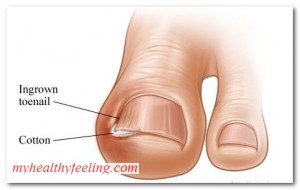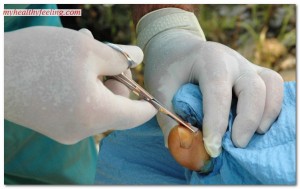How to treat an ingrown toenail? Ingrown toenail home treatment is possible by you, if the condition is at its initial stage but during the later stages, it may need other ways of removal or even surgery.
A condition is classified to be ingrown toenail if the nail of toes, particularly the corners or sides of the nail, curls inwards digging the skin. This phenomenon may also lead to pain and irritation. The curled ingrown toenail pokes at the skin which may cause the region to protrude or also to become sore. Possibly any of the toes can have ingrown toenail, but big toe is at higher risk as compared to other toes.
It is essential to take such condition very seriously ingrown toenail relief should be done soon as possible. The condition can lead to infected toenail to infection and if it is not treated timely, it can be at risk to other health complications. There are reports of ingrown toenail cases which progressed into abscess which is a severe condition that needs surgery.
Symptoms of ingrown toenail:
Symptoms of Ingrown toenail can be easily understood. However, it is generally characterized by redness and extrusion visible at the corner of the nails. This is during the initial stage where only redness and swelling is noticed without any fluid or pus accumulated in it. When the infected toe nail develops further it also causes pain and inflammation. During such advanced stage, ingrown toenail treatment is urgently needed as white drainage or yellow colored fluid may occur. The infection may also lead to fever which may also hinder activities of the affected person.
Any mild conditions can get maturated if you wear tight shoes when ingrown toenail is noticed. At the same time ensuring cleanliness of the ingrown toenail is essential during its initial stage. Other factors causing infected toe nail are injury to toes, fungal infection of nails etc.
Ingrown toenail pictures
Check out ingrown toenail pictures and how the toe can get infected
Ingrown toenail diagnosis:
An ingrown toenail treatment starts with its diagnosis. A doctor may first look into the history of the condition and try to find out the root cause of the issue. There are possibilities that your health care provider may also ask for any associated medical condition or drugs that you may have taken as ingrown toenail treatment.
Obviously a doctor will be able to tell you whether you have ingrown toenail just by looking at your toes or by a simple physical examination. In case the condition looks advanced and severe then he may perform further analysis such as blood pressure, body temperature and so on. In some cases you may have to undergo special imaging diagnosis such as x-ray MRI scanning etc.
Ingrown toenail treatment:
Ingrown toenail treatment at home can be done by you, if the condition is at its initial stages. Lift the nail part that is pushing into your skin, keep it lifted with a small piece of cotton. You may take pain reliever to lessen the pain, in case it hurts. Keep your infected foot in warm water four times a day. Do not add perfume based soap in the water. Wash the nail area with regular water and soap. Do not wear tight shoes or footwear that can cause suffocation to the toenail. You can rather wear comfortable footwear like slippers or sandals.
You may call the doctor for ingrown nail treatment, if there is no change in the condition or if the problem seems to increase. He may or may not advise you to go for ingrown toenail treatment surgery. If the infection is more, then only there is a need for invasive treatment. During surgery, the doctor will drain the abscess. Let your doctor know if you have not had a tetanus shot in the last five years, he will do so before surgery.



